Roman portraiture
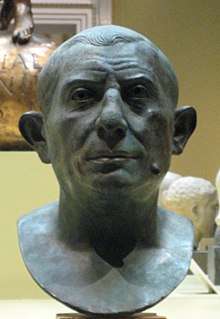
Roman portraiture was one of the most significant periods in the development of portrait art. Originating from ancient Rome, it continued for almost five centuries. Roman portraiture is characterised by unusual realism and the desire to convey images of nature in the high quality style often seen in ancient Roman art. Some busts even seem to show clinical signs.[1] Several images and statues made in marble and bronze have survived in small numbers. Roman funerary art includes many portraits such as married couple funerary reliefs, which were most often made for wealthy freedmen rather than the patrician elite.
Portrait sculpture from the Republican era tends to be somewhat more modest, realistic, and natural compared to early Imperial works. A typical work might be one like the standing figure "A Roman Patrician with Busts of His Ancestors" (c. 30 B.C.).[2]
By the imperial age, though they were often realistic depictions of human anatomy, portrait sculpture of Roman emperors were often used for propaganda purposes and included ideological messages in the pose, accoutrements, or costume of the figure. Since most emperors from Augustus on were deified, some images are somewhat idealized. The Romans also depicted warriors and heroic adventures, in the spirit of the Greeks who came before them.
Ideology
Religious functions and origins
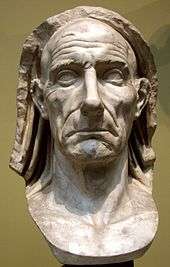
The origin of the realism of Roman portraits may be, according to some scholars, because they evolved from wax death masks. These death masks were taken from bodies and kept in a home altar. Besides wax, masks were made from bronze, marble and terracotta. The molds for the masks were made directly from the deceased, giving historians an accurate representation of typically Roman features.
Politics
In the days of the Republic, full-size statues of political officials and military commanders were often erected in public places. Such an honor was provided by the decision of the Senate, usually in commemoration of victories, triumphs and political achievements. These portraits were usually accompanied by a dedicatory inscription. If the person commemorated with a portrait was found to have committed a crime, the portrait would be destroyed.
Social and psychological aspect
Development of the Roman portrait was associated with increased interest in the individual, with the expansion of the social circle portrayed. At the heart of the artistic structure of many Roman portraits is the clear and rigorous transfer of unique features of the model, while still keeping the general style very similar. Unlike the ancient Greek portraits that strived for idealization (the Greeks believed that a good man must be beautiful), Roman portrait sculpture was far more natural and is still considered one of the most realistic samples of the genre in the history of art.
Historical development
Republican period
 The bronze bust of Lucius Junius Brutus, the Capitoline Brutus in the Musei Capitolini, dated late 4th century BC to early 3rd century BC
The bronze bust of Lucius Junius Brutus, the Capitoline Brutus in the Musei Capitolini, dated late 4th century BC to early 3rd century BC The Orator, c. 100 BC, an Etrusco-Roman bronze statue depicting Aule Metele (Latin: Aulus Metellus), an Etruscan man wearing a Roman toga while engaged in rhetoric; the statue features an inscription in the Etruscan alphabet
The Orator, c. 100 BC, an Etrusco-Roman bronze statue depicting Aule Metele (Latin: Aulus Metellus), an Etruscan man wearing a Roman toga while engaged in rhetoric; the statue features an inscription in the Etruscan alphabet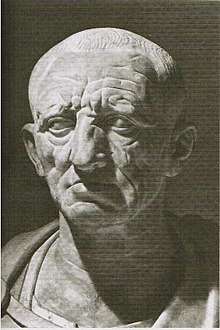 The Patrician Torlonia bust of Cato the Elder. 1st century BC
The Patrician Torlonia bust of Cato the Elder. 1st century BC- Scipio Africanus, bronze bust, mid 1st century BC

- The Grave relief of Publius Aiedius and Aiedia, 30 BC, Pergamon Museum (Berlin)
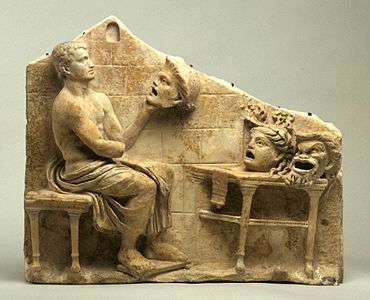 Roman, Republican or Early Imperial, Relief of a seated poet (Menander) with masks of New Comedy, 1st century BC – early 1st century AD, Princeton University Art Museum
Roman, Republican or Early Imperial, Relief of a seated poet (Menander) with masks of New Comedy, 1st century BC – early 1st century AD, Princeton University Art Museum
Imperial period
Roman portraiture of the Imperial period includes works created throughout the provinces, often combining Greek, Roman, and local traditions, as with the Fayum mummy portraits.
 L. Calpurnius Piso Pontifex, late 1st century BC–early 1st century AD
L. Calpurnius Piso Pontifex, late 1st century BC–early 1st century AD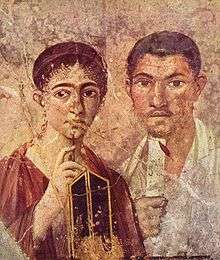 Husband and wife from Pompeii, 20–30 AD (Portrait of Paquius Proculo)
Husband and wife from Pompeii, 20–30 AD (Portrait of Paquius Proculo) Young woman with Flavian-era hairstyle, 80s–90s AD
Young woman with Flavian-era hairstyle, 80s–90s AD
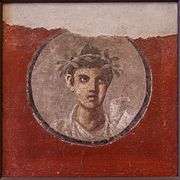
- Ancient Roman fresco, Pompeian Fourth Style (45-79 AD), National Archaeological Museum of Naples, Italy
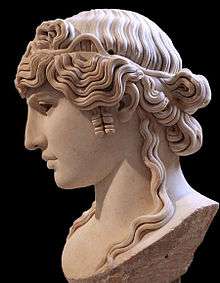 Antinous, ca. 130 AD
Antinous, ca. 130 AD_01.jpg) Vibia Sabina, ca. 130 AD
Vibia Sabina, ca. 130 AD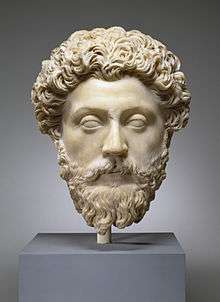
 Mummy portrait from Roman Egypt, 2nd–3rd century AD
Mummy portrait from Roman Egypt, 2nd–3rd century AD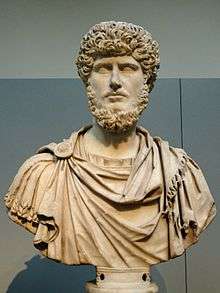 Portrait of Lucius Verus
Portrait of Lucius Verus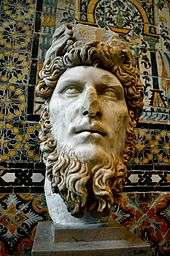 Ancient bust of Roman emperor Lucius Verus (r. 161-169 AD), a natural blond who would sprinkle gold dust in his hair to make it even blonder,[3] Bardo National Museum, Tunis
Ancient bust of Roman emperor Lucius Verus (r. 161-169 AD), a natural blond who would sprinkle gold dust in his hair to make it even blonder,[3] Bardo National Museum, Tunis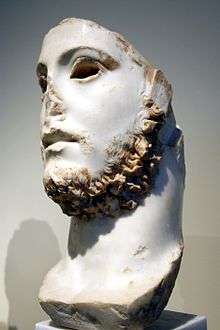 Remnants of a Roman bust of a youth with a blond beard, perhaps depicting Roman emperor Commodus (r. 177-192 AD), National Archaeological Museum, Athens
Remnants of a Roman bust of a youth with a blond beard, perhaps depicting Roman emperor Commodus (r. 177-192 AD), National Archaeological Museum, Athens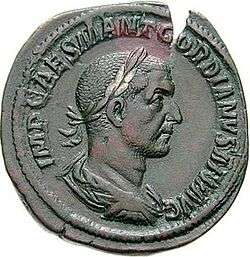 Portrait of the emperor Gordianus I (238) on a bronze sestertius
Portrait of the emperor Gordianus I (238) on a bronze sestertius_und_ihre_Kinder.jpg)
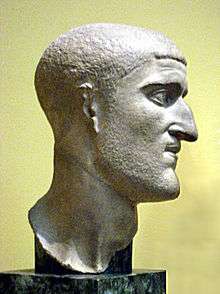 Portrait of Constantius Chlorus (r. 293-306 AD)
Portrait of Constantius Chlorus (r. 293-306 AD)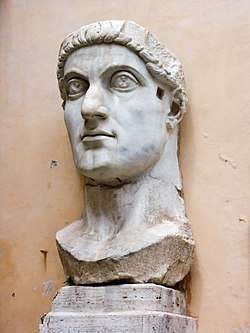 Colossus of Constantine, 312–315 AD
Colossus of Constantine, 312–315 AD Bust depicting an idealized portrait of Menander of Ephesus, 4th century AD, Ephesus Archaeological Museum
Bust depicting an idealized portrait of Menander of Ephesus, 4th century AD, Ephesus Archaeological Museum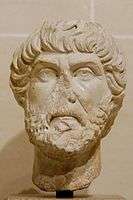 Marble bust of an orator or philosopher, 5th century AD, Louvre
Marble bust of an orator or philosopher, 5th century AD, Louvre
See also
References
| Wikimedia Commons has media related to Ancient Roman portraits. |
- ↑ Engmann B: Neurologic diseases in ancient Roman sculpture busts. Neurol Clin Pract December 2013 vol.3 no.6:539-541. doi: 10.1212/CPJ.0b013e3182a78f02
- ↑ Janson, p. 197
- ↑ Michael Grant (1994). The Antonines: The Roman Empire in Transition. London & New York: Routledge. ISBN 0-415-10754-7, pp 27-28.
- ↑ Daniel Thomas Howells (2015). "A Catalogue of the Late Antique Gold Glass in the British Museum (PDF)." London: the British Museum (Arts and Humanities Research Council). Accessed 2 October 2016, p. 7.
- ↑ Jás Elsner (2007). "The Changing Nature of Roman Art and the Art Historical Problem of Style," in Eva R. Hoffman (ed), Late Antique and Medieval Art of the Medieval World, 11-18. Oxford, Malden & Carlton: Blackwell Publishing. ISBN 978-1-4051-2071-5, p. 17, Figure 1.3 on p. 18.
Bibliography
- (in Italian) Ranuccio Bianchi Bandinelli, Il problema del ritratto, in L'arte classica, Editori Riuniti, Rome 1984.
- (in Italian) Ranuccio Bianchi Bandinelli e Mario Torelli, L'arte dell'antichità classica, Etruria-Roma, Utet, Turin 1976.
- (in Italian) Pierluigi De Vecchi & Elda Cerchiari, I tempi dell'arte, volume 1, Bompiani, Milan 1999
- http://www.getty.edu/publications/virtuallibrary/0866590048.html?imprint=jpgt&pg=6&res=20